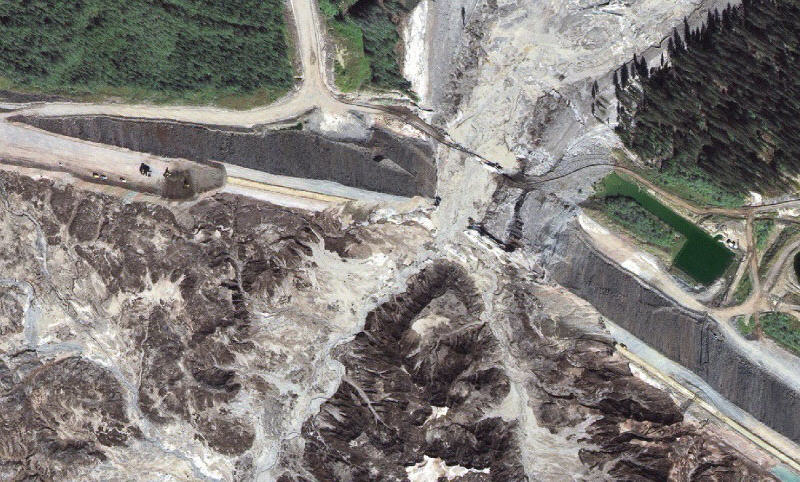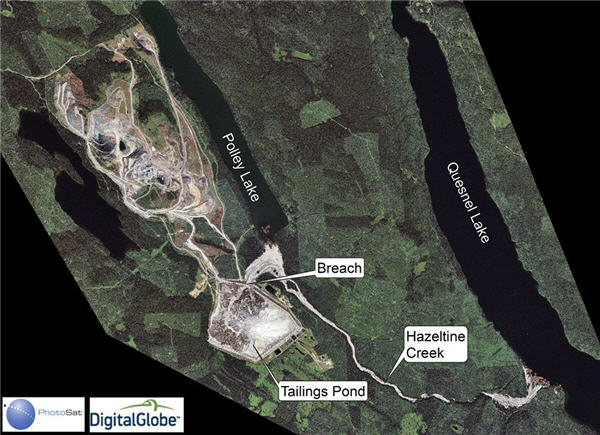Imperial Metal to raise $100 M to cover Mount Polley cleanup costs

Image from PhotoSat
Imperial Metals Corp. (TSX:III) will raise $100 million through debentures to cover the cleanup costs of its Mount Polley mine disaster, and plans to move ahead with the commissioning of its Red Chris mine, despite the project being $61 million over budget and picketed by First Nations.
Imperial’s battered stocks took a healthy bump of more than 10% August 15, with the release of the company’s second quarter financial statements.
Imperial’s stocks dropped 40% in a single day, from $16.80 to $9.98, on August 5, the day after the Mount Polley tailings pond dam collapsed in what has been called the worst mine-related environmental disaster in B.C. history.
The tailings pond breach forced the shut down of the Mount Polley mine, Imperial’s biggest money-maker.
It will remain idle for “an indeterminate period of time,” the company said in its Q2 statements.
“While the precise costs of remediation and repair are presently unknown, the company believes that the costs can be managed over time given the underlying value of the company’s assets and by the resources provided by the additional financing as detailed below together with insurance proceeds,” the company stated.
Imperial announced it will raise $100 million in debt. Murray Edwards, the company’s largest shareholder, will buy $40 million of the six-year senior unsecured convertible debentures through is company, Edco Capital Corp. Fairholme Partnership LP will also buy $40 million worth of debentures.
Imperial’s flagship project, the Red Chris mine, is nearing completion and was already starting to produce ore when the Mount Polley mine incident occurred.
At least one mine analyst said he thought the Mount Polley incident would result in the Red Chris mine being delayed by a year.
But in its Q2 financials, the company signaled it plans to move ahead with the project, despite cost overruns unrelated to the Mount Polley incident.
The company estimates the total capital costs to be $631 million, up from the $570 million.
The mine itself accounts for $25 million of the cost overrun. The balance – $36 million – is related to the construction of the Iskut extension – a transmission line that ties the mine into the new Northwest Transmission line.
The Northwest Transmission line was officially commissioned August 13. It was built specifically to power Red Chris and other mines planned for the area.
The Iskut extension is expected to be complete in September, “after which commission of the Red Chris mine can begin,” the company said.
Both the Red Chris mine and a proposed zinc-lead mine Imperial wants to build north of Kamloops – Ruddock Creek – is now facing heated opposition from First Nations.
On August 14, as Imperial Metals executives were putting their second quarter financial report to bed, the Neskonlith Indian Band were knocking on the company’s doors in downtown Vancouver in order to serve the company with an eviction notice aimed at stopping any further work on a proposed zinc-lead mine at Ruddock Creek.
Meanwhile, a group of Tahltan First Nation activists called the Klabona Keepers have been blockading the entrance to the company’s Red Chris mine.
The group consists of members of the Tahltan First Nation, but do not represent the Tahltan’s governing body, the Tahltan Central Council.
The Tahltan have been negotiating a benefits agreement with Imperial on the Red Chris mine. It has not been finalized yet, although the Tahtan recently suggested the Mount Polley disaster has not caused the First Nation to back away from the Red Chris project.
Tahltan Central Council President Chad Norman Day said the Tahltan are reaching out to both Imperial Metals and the Klabona Keepers.
“We have reached out to the Klabona Keepers and are keen to discuss their intentions behind the blockade,” Day said in a prepared statement.
“We share their concerns in protecting the Tahltan environment, culture and our local communities into the future. We are and will continue to do everything in our power to make sure the Tahltan Nation avoids serious environmental issues at the Red Chris Mine.”
By Nelson Bennett

Image by Photosat
{{ commodity.name }}
{{ post.title }}
{{ post.date }}





4 Comments
Marc Zimmer
Good start, I suppose.
rayban
OK , good recovery from thr original supposed breach answers . Now , if they actually spend the money in a timely manner and fully remediate the disaster , or spend ALL the money in a timely manner and fully remediate the disaster . Now about redsigning a new tailings facility and building it . From the 100 million ?
If I sound doubtful it is because I stand to lose big if this goes wrong . As well future developments are subject to effects of this disaster . Think not , look at a much worse disaster called Fukishima Japan and downsize the later issues a little , ie the price of U308 and countries switching to gas and Coal . I wish all the best to Imperial and the Environmentalists as well , but please get this right .
Two-Tongues Lebeaux
All the gravel in the creeks in the Cariboo Area were turned over and run
thought a sluice boxes in the 1800’s during the Gold rush….and the fish
survived!
The three lakes around the Mount Polley Mine (Polley lake, Bootjack lake,
Morehead lake) are all man made by the ‘Bullion Pit’ placers miners.
The placer miners working at the BULLION PIT near
Likey (behind the Mount Polley Mine) dammed up the 3 creeks and created those
lakes to supply water for their HYDRAULIC mining process at the Bullion
Pit.
It ran for 50 years (1891-1941) creating the biggest Placer Pits in the
world. It’s a local tourist attraction today. The BULLION Mine had no Tailing
dam, all the tailings (toxic sludge) went directly into the Cariboo River all
day, very summer for 50 years!….and the fish survived. So the tests are back
and the Toxic Sludge turns out to be “not toxic” and only has slightly elevated
copper. I think slightly elevated cooper locked in these tailings sand will have
ZERO impact on the fish. The water pipes in our houses are made of pure
copper…..how much copper is leaching out of these pipes everyday…why don’t
we freak out about that?
(Google: BULLION PIT for PETER R. MULVIHILL’s paper on this for more
info).
wally
Personally, I feel this shows that Imperial have a real commitment to dealing with this issue in a responsible way. Lets hope improved (perhaps self imposed) standards are a result, which will benefit everyone not least shareholders of mining stocks.